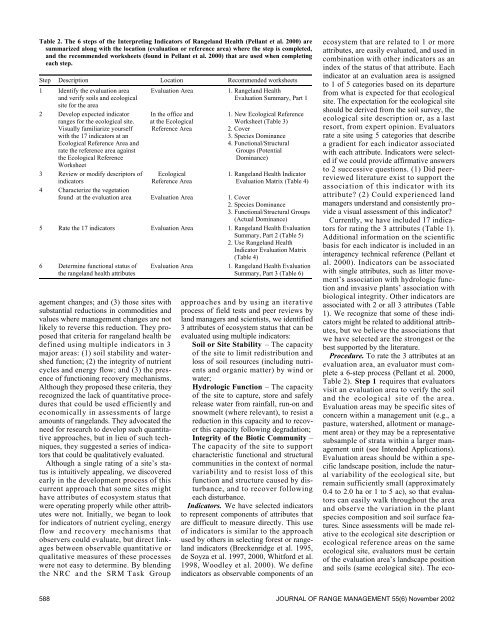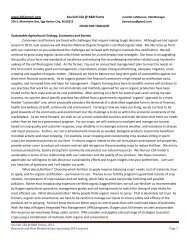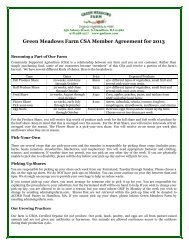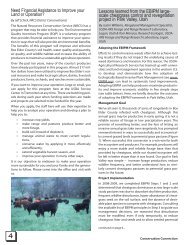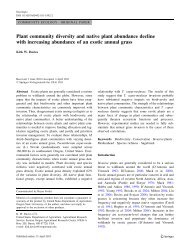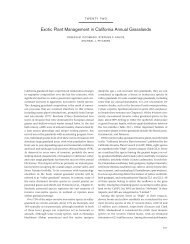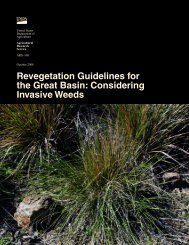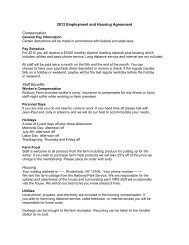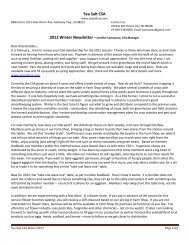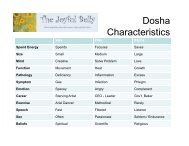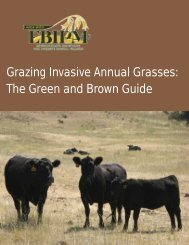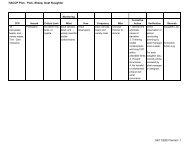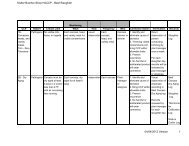Rangeland health attributes and indicators for qualitative assessment
Rangeland health attributes and indicators for qualitative assessment
Rangeland health attributes and indicators for qualitative assessment
Create successful ePaper yourself
Turn your PDF publications into a flip-book with our unique Google optimized e-Paper software.
Table 2. The 6 steps of the Interpreting Indicators of <strong>Rangel<strong>and</strong></strong> Health (Pellant et al. 2000) are<br />
summarized along with the location (evaluation or reference area) where the step is completed,<br />
<strong>and</strong> the recommended worksheets (found in Pellant et al. 2000) that are used when completing<br />
each step.<br />
Step Description Location Recommended worksheets<br />
1 Identify the evaluation area Evaluation Area 1. <strong>Rangel<strong>and</strong></strong> Health<br />
<strong>and</strong> verify soils <strong>and</strong> ecological Evaluation Summary, Part 1<br />
site <strong>for</strong> the area<br />
2 Develop expected indicator In the office <strong>and</strong> 1. New Ecological Reference<br />
ranges <strong>for</strong> the ecological site. at the Ecological Worksheet (Table 3)<br />
Visually familiarize yourself Reference Area 2. Cover<br />
with the 17 <strong>indicators</strong> at an<br />
3. Species Dominance<br />
Ecological Reference Area <strong>and</strong><br />
4. Functional/Structural<br />
rate the reference area against<br />
Groups (Potential<br />
the Ecological Reference<br />
Dominance)<br />
Worksheet<br />
3 Review or modify descriptors of Ecological 1. <strong>Rangel<strong>and</strong></strong> Health Indicator<br />
<strong>indicators</strong> Reference Area Evaluation Matrix (Table 4)<br />
4 Characterize the vegetation<br />
found at the evaluation area Evaluation Area 1. Cover<br />
2. Species Dominance<br />
3. Functional/Structural Groups<br />
(Actual Dominance)<br />
5 Rate the 17 <strong>indicators</strong> Evaluation Area 1. <strong>Rangel<strong>and</strong></strong> Health Evaluation<br />
Summary, Part 2 (Table 5)<br />
2. Use <strong>Rangel<strong>and</strong></strong> Health<br />
Indicator Evaluation Matrix<br />
(Table 4)<br />
6 Determine functional status of Evaluation Area 1. <strong>Rangel<strong>and</strong></strong> Health Evaluation<br />
the rangel<strong>and</strong> <strong>health</strong> <strong>attributes</strong> Summary, Part 3 (Table 6)<br />
agement changes; <strong>and</strong> (3) those sites with<br />
substantial reductions in commodities <strong>and</strong><br />
values where management changes are not<br />
likely to reverse this reduction. They proposed<br />
that criteria <strong>for</strong> rangel<strong>and</strong> <strong>health</strong> be<br />
defined using multiple <strong>indicators</strong> in 3<br />
major areas: (1) soil stability <strong>and</strong> watershed<br />
function; (2) the integrity of nutrient<br />
cycles <strong>and</strong> energy flow; <strong>and</strong> (3) the presence<br />
of functioning recovery mechanisms.<br />
Although they proposed these criteria, they<br />
recognized the lack of quantitative procedures<br />
that could be used efficiently <strong>and</strong><br />
economically in <strong>assessment</strong>s of large<br />
amounts of rangel<strong>and</strong>s. They advocated the<br />
need <strong>for</strong> research to develop such quantitative<br />
approaches, but in lieu of such techniques,<br />
they suggested a series of <strong>indicators</strong><br />
that could be <strong>qualitative</strong>ly evaluated.<br />
Although a single rating of a site’s status<br />
is intuitively appealing, we discovered<br />
early in the development process of this<br />
current approach that some sites might<br />
have <strong>attributes</strong> of ecosystem status that<br />
were operating properly while other <strong>attributes</strong><br />
were not. Initially, we began to look<br />
<strong>for</strong> <strong>indicators</strong> of nutrient cycling, energy<br />
flow <strong>and</strong> recovery mechanisms that<br />
observers could evaluate, but direct linkages<br />
between observable quantitative or<br />
<strong>qualitative</strong> measures of these processes<br />
were not easy to determine. By blending<br />
the NRC <strong>and</strong> the SRM Task Group<br />
approaches <strong>and</strong> by using an iterative<br />
process of field tests <strong>and</strong> peer reviews by<br />
l<strong>and</strong> managers <strong>and</strong> scientists, we identified<br />
3 <strong>attributes</strong> of ecosystem status that can be<br />
evaluated using multiple <strong>indicators</strong>:<br />
Soil or Site Stability – The capacity<br />
of the site to limit redistribution <strong>and</strong><br />
loss of soil resources (including nutrients<br />
<strong>and</strong> organic matter) by wind or<br />
water;<br />
Hydrologic Function – The capacity<br />
of the site to capture, store <strong>and</strong> safely<br />
release water from rainfall, run-on <strong>and</strong><br />
snowmelt (where relevant), to resist a<br />
reduction in this capacity <strong>and</strong> to recover<br />
this capacity following degradation;<br />
Integrity of the Biotic Community –<br />
The capacity of the site to support<br />
characteristic functional <strong>and</strong> structural<br />
communities in the context of normal<br />
variability <strong>and</strong> to resist loss of this<br />
function <strong>and</strong> structure caused by disturbance,<br />
<strong>and</strong> to recover following<br />
each disturbance.<br />
Indicators. We have selected <strong>indicators</strong><br />
to represent components of <strong>attributes</strong> that<br />
are difficult to measure directly. This use<br />
of <strong>indicators</strong> is similar to the approach<br />
used by others in selecting <strong>for</strong>est or rangel<strong>and</strong><br />
<strong>indicators</strong> (Breckenridge et al. 1995,<br />
de Soyza et al. 1997, 2000, Whit<strong>for</strong>d et al.<br />
1998, Woodley et al. 2000). We define<br />
<strong>indicators</strong> as observable components of an<br />
ecosystem that are related to 1 or more<br />
<strong>attributes</strong>, are easily evaluated, <strong>and</strong> used in<br />
combination with other <strong>indicators</strong> as an<br />
index of the status of that attribute. Each<br />
indicator at an evaluation area is assigned<br />
to 1 of 5 categories based on its departure<br />
from what is expected <strong>for</strong> that ecological<br />
site. The expectation <strong>for</strong> the ecological site<br />
should be derived from the soil survey, the<br />
ecological site description or, as a last<br />
resort, from expert opinion. Evaluators<br />
rate a site using 5 categories that describe<br />
a gradient <strong>for</strong> each indicator associated<br />
with each attribute. Indicators were selected<br />
if we could provide affirmative answers<br />
to 2 successive questions. (1) Did peerreviewed<br />
literature exist to support the<br />
association of this indicator with its<br />
attribute (2) Could experienced l<strong>and</strong><br />
managers underst<strong>and</strong> <strong>and</strong> consistently provide<br />
a visual <strong>assessment</strong> of this indicator<br />
Currently, we have included 17 <strong>indicators</strong><br />
<strong>for</strong> rating the 3 <strong>attributes</strong> (Table 1).<br />
Additional in<strong>for</strong>mation on the scientific<br />
basis <strong>for</strong> each indicator is included in an<br />
interagency technical reference (Pellant et<br />
al. 2000). Indicators can be associated<br />
with single <strong>attributes</strong>, such as litter movement’s<br />
association with hydrologic function<br />
<strong>and</strong> invasive plants’ association with<br />
biological integrity. Other <strong>indicators</strong> are<br />
associated with 2 or all 3 <strong>attributes</strong> (Table<br />
1). We recognize that some of these <strong>indicators</strong><br />
might be related to additional <strong>attributes</strong>,<br />
but we believe the associations that<br />
we have selected are the strongest or the<br />
best supported by the literature.<br />
Procedure. To rate the 3 <strong>attributes</strong> at an<br />
evaluation area, an evaluator must complete<br />
a 6-step process (Pellant et al. 2000,<br />
Table 2). Step 1 requires that evaluators<br />
visit an evaluation area to verify the soil<br />
<strong>and</strong> the ecological site of the area.<br />
Evaluation areas may be specific sites of<br />
concern within a management unit (e.g., a<br />
pasture, watershed, allotment or management<br />
area) or they may be a representative<br />
subsample of strata within a larger management<br />
unit (see Intended Applications).<br />
Evaluation areas should be within a specific<br />
l<strong>and</strong>scape position, include the natural<br />
variability of the ecological site, but<br />
remain sufficiently small (approximately<br />
0.4 to 2.0 ha or 1 to 5 ac), so that evaluators<br />
can easily walk throughout the area<br />
<strong>and</strong> observe the variation in the plant<br />
species composition <strong>and</strong> soil surface features.<br />
Since <strong>assessment</strong>s will be made relative<br />
to the ecological site description or<br />
ecological reference areas on the same<br />
ecological site, evaluators must be certain<br />
of the evaluation area’s l<strong>and</strong>scape position<br />
<strong>and</strong> soils (same ecological site). The eco-<br />
588 JOURNAL OF RANGE MANAGEMENT 55(6) November 2002


